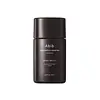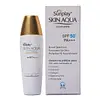What's inside
What's inside
 Key Ingredients
Key Ingredients

 Benefits
Benefits

 Concerns
Concerns

 Ingredients Side-by-side
Ingredients Side-by-side

Water
Skin ConditioningDibutyl Adipate
EmollientHouttuynia Cordata Extract
Skin ConditioningAlcohol
AntimicrobialCaprylyl Methicone
Skin ConditioningDiethylamino Hydroxybenzoyl Hexyl Benzoate
UV FilterBis-Ethylhexyloxyphenol Methoxyphenyl Triazine
Skin ConditioningPhenethyl Benzoate
EmollientPolymethylsilsesquioxane
Polysilicone-15
UV FilterMethylene Bis-Benzotriazolyl Tetramethylbutylphenol
UV FilterEthylhexyl Triazone
UV AbsorberHexyl Laurate
EmollientNiacinamide
SmoothingPolyglyceryl-6 Stearate
EmollientDiethylhexyl Butamido Triazone
UV AbsorberAspergillus Ferment
Skin ConditioningTriticum Aestivum Seed Extract
Perfuming1,2-Hexanediol
Skin ConditioningPentylene Glycol
Skin ConditioningC20-22 Alkyl Phosphate
EmulsifyingPanthenol
Skin ConditioningDecyl Glucoside
CleansingHydroxyacetophenone
AntioxidantTromethamine
BufferingEthylhexyl Olivate
Skin ConditioningPolyglyceryl-6 Behenate
Emulsion StabilisingSodium Acrylates Copolymer
Polyglyceryl-4 Oleate
EmulsifyingDipotassium Glycyrrhizate
HumectantAdenosine
Skin ConditioningGlycerin
HumectantSodium Phytate
Maltodextrin
AbsorbentLipase
Skin ConditioningProtease
ExfoliatingC20-22 Alcohols
Emulsion StabilisingXanthan Gum
EmulsifyingWater, Dibutyl Adipate, Houttuynia Cordata Extract, Alcohol, Caprylyl Methicone, Diethylamino Hydroxybenzoyl Hexyl Benzoate, Bis-Ethylhexyloxyphenol Methoxyphenyl Triazine, Phenethyl Benzoate, Polymethylsilsesquioxane, Polysilicone-15, Methylene Bis-Benzotriazolyl Tetramethylbutylphenol, Ethylhexyl Triazone, Hexyl Laurate, Niacinamide, Polyglyceryl-6 Stearate, Diethylhexyl Butamido Triazone, Aspergillus Ferment, Triticum Aestivum Seed Extract, 1,2-Hexanediol, Pentylene Glycol, C20-22 Alkyl Phosphate, Panthenol, Decyl Glucoside, Hydroxyacetophenone, Tromethamine, Ethylhexyl Olivate, Polyglyceryl-6 Behenate, Sodium Acrylates Copolymer, Polyglyceryl-4 Oleate, Dipotassium Glycyrrhizate, Adenosine, Glycerin, Sodium Phytate, Maltodextrin, Lipase, Protease, C20-22 Alcohols, Xanthan Gum
Water
Skin ConditioningCyclopentasiloxane
EmollientEthylhexyl Methoxycinnamate
UV AbsorberZinc Oxide
Cosmetic ColorantButylene Glycol
HumectantGlycerin
HumectantIsononyl Isononanoate
EmollientPEG-9 Polydimethylsiloxyethyl Dimethicone
EmulsifyingAscorbyl Glucoside
AntioxidantSilica
AbrasivePolymethylsilsesquioxane
Disodium Phosphate
BufferingEthylhexyl Dimethoxybenzylidene Dioxoimidazolidine Propionate
UV AbsorberLauroyl Lysine
Skin ConditioningTitanium Dioxide
Cosmetic ColorantAcrylates/Dimethicone Copolymer
Skin ConditioningMethyl/Phenyl Polysilsesquioxane
Sodium Hydroxide
BufferingMethylparaben
PreservativeDisodium EDTA
Propylparaben
PreservativeStearyl Glycyrrhetinate
Skin ConditioningPotassium Hydroxide
BufferingArginine
MaskingHyaluronic Acid
HumectantTocopheryl Acetate
AntioxidantHydrolyzed Collagen
EmollientWater, Cyclopentasiloxane, Ethylhexyl Methoxycinnamate, Zinc Oxide, Butylene Glycol, Glycerin, Isononyl Isononanoate, PEG-9 Polydimethylsiloxyethyl Dimethicone, Ascorbyl Glucoside, Silica, Polymethylsilsesquioxane, Disodium Phosphate, Ethylhexyl Dimethoxybenzylidene Dioxoimidazolidine Propionate, Lauroyl Lysine, Titanium Dioxide, Acrylates/Dimethicone Copolymer, Methyl/Phenyl Polysilsesquioxane, Sodium Hydroxide, Methylparaben, Disodium EDTA, Propylparaben, Stearyl Glycyrrhetinate, Potassium Hydroxide, Arginine, Hyaluronic Acid, Tocopheryl Acetate, Hydrolyzed Collagen
 Reviews
Reviews

Ingredients Explained
These ingredients are found in both products.
Ingredients higher up in an ingredient list are typically present in a larger amount.
Glycerin is already naturally found in your skin. It helps moisturize and protect your skin.
A study from 2016 found glycerin to be more effective as a humectant than AHAs and hyaluronic acid.
As a humectant, it helps the skin stay hydrated by pulling moisture to your skin. The low molecular weight of glycerin allows it to pull moisture into the deeper layers of your skin.
Hydrated skin improves your skin barrier; Your skin barrier helps protect against irritants and bacteria.
Glycerin has also been found to have antimicrobial and antiviral properties. Due to these properties, glycerin is often used in wound and burn treatments.
In cosmetics, glycerin is usually derived from plants such as soybean or palm. However, it can also be sourced from animals, such as tallow or animal fat.
This ingredient is organic, colorless, odorless, and non-toxic.
Glycerin is the name for this ingredient in American English. British English uses Glycerol/Glycerine.
Learn more about GlycerinPolymethylsilsesquioxane is a silicone used as a film forming agent.
When applied to the skin, this ingredient creates an invisible film on the surface. This film still allows oxygen to pass through, but prevents moisture from escaping. This can help condition and hydrate the skin. It also leaves a silky feel when applied.
Polymethylsilsesquioxane has not been shown to clog pores. It has been deemed safe to use up to 55%, but most cosmetics use much less.
If you have concerns about using this ingredient, we recommend speaking with a professional.
Learn more about PolymethylsilsesquioxaneWater. It's the most common cosmetic ingredient of all. You'll usually see it at the top of ingredient lists, meaning that it makes up the largest part of the product.
So why is it so popular? Water most often acts as a solvent - this means that it helps dissolve other ingredients into the formulation.
You'll also recognize water as that liquid we all need to stay alive. If you see this, drink a glass of water. Stay hydrated!
Learn more about Water